|
|
|
|
|
|
The parts
|
|
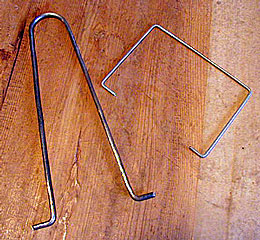 |
|
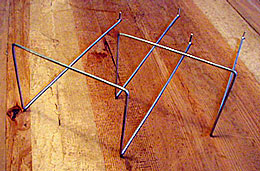 |
|
| The main frame is in two halves -- front/back and top/bottom. Use 10-gauge wire (1/8", 3mm). (Gauges and measures are approximate.) |
|
|
| The square bit is the door frame, with the door bar. The bar is 10" high (25.5cm). The bar must be strong, use at least 8-gauge wire -- 5/32", 4mm. |
|
|
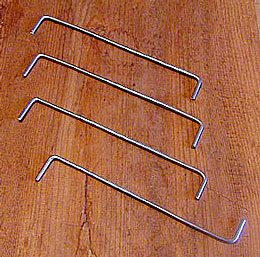 |
|
 |
|
|
|
The top one holds the trigger holding pin; the trigger and the holding pin are of thinner wire, 1/16", 2mm. |
|
| The top two are for the frame ends and for the door, the bottom one is a cross-piece, to hold the trigger. |
|
|
|
|
|
|
|
|
|
|
|
|
|
|
|
|
|
Assembly
|
|
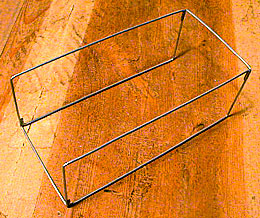 |
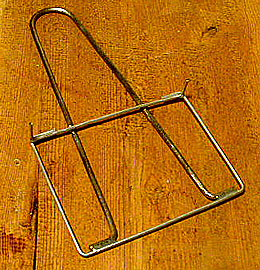 |
|
| Join the two main frame sections -- braze and/or bind firmly with thin wire. |
|
 |
|
| The door assembly -- the top section of the door frame is attached so that the two ends stick up vertically. |
|
|
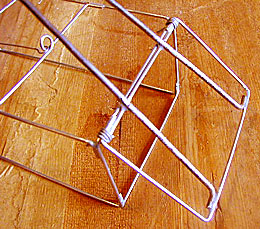 |
|
| The door connects to the frame end with the joining section at the bottom. The two protruding door joining section ends go inside. Wire binding at each side acts as hinges. |
|
| Another view. |
|
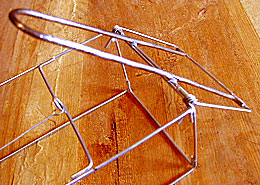 |
|
 |
|
| How the various sections at the front are joined. |
|
| Another view, with holding pin and trigger mounted to their cross-sections. |
|
|
 |
|
|
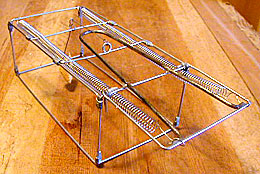 |
|
| The trap, finished but for the chicken wire covering. Baited and set. The springs are connected from the top corners at the back to the bottom corners of the door. Use strong springs, holding the door closed with a few pounds' pressure. Never underestimate the strength of a rat. |
|
| Another view of the holding pin and trigger. |
|
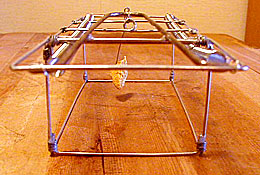 |
|
|
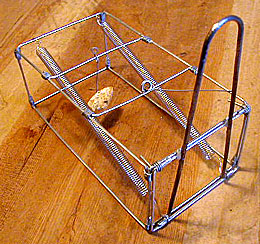 |
|
| The trigger is sensitive -- any movement of the bait will spring the trap. We caught hundreds of rats with these traps, they didn't ever fail, and no rat ever escaped. |
|
|
|
|
|
|
|
|
|
|
NOTE: The assembled frame and the door section should be covered with 1/2" chicken wire before the door is connected to the frame. We've left the chicken wire off here for the sake of clearer illustrations. Use thin wire to bind the chicken wire to the frame and door -- do a thorough job!
How to Make Springs -- online book, written "for the benefit of someone who has (or can gain access to) basic hand and power tools". Arranged in logical order presuming minimal knowledge of the metalworking trades or of springmaking, cross-linked to provide a forward path through the entire manufacturing process.
http://home.earthlink.net/~bazillion/intro.html
Bait
Nordic rats -- "sewer rats" -- are carnivorous, or omnivorous. Most "country" rats, the ones that damage crops, are mostly vegetarians, they like grains, tubers, fruit, as well as insects. For Nordic rats, a piece of cooked meat or fat is good bait. Take care, such bait may also attract cats. For country rats, we found any combination of wholewheat bread crust, raisins, peanut butter, fresh pumpkin or squash pith (including seeds) worked every time.
A better rat trap
Rats and owls
Chinese rat trap
How to make a Chinese rat trap
Bucket rat trap
Appropriate technology
Appropriate technology resources
- Agriculture resources
- Wood resources
Blacksmithing
Wood fires that fit
Houses that fit
Water-powered water pumps
Journey to Forever and AT
- Chinese watering cans
- Handmade Projects watering can plans
- Hoe for victory!
- Billhooks and sickles
A better rat trap
- Rats and owls
- Chinese rat trap
- How to make a Chinese rat trap
- Bucket rat trap
Appropriate technology subjects














